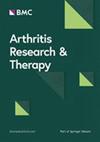核因子- κ B配体衍生的小胶质细胞愈合肽受体激活剂1-AcN抑制小鼠骨关节炎进展
IF 4.6
2区 医学
Q1 Medicine
引用次数: 0
摘要
骨关节炎(OA)是一种以软骨下骨硬化、慢性炎症和软骨退化为特征的退行性疾病。半月板偏离引起的异常机械应力激活破骨细胞,诱导转化生长因子β (TGF-β)的释放,促进间充质干细胞(MSC)介导的H型血管生成和成骨,导致骨硬化和软骨损伤。随后,巨噬细胞通过toll样受体4 (TLR4)识别软骨源性损伤相关分子模式(DAMPs),极化为促炎M1表型,从而加剧滑膜炎和软骨损失。我们开发了具有n端乙酰化和c端酰胺化的小胶质细胞愈合肽1 (MHP1-AcN),这是一种源自核因子- κ B配体受体激活剂(RANKL)的修饰肽,具有抗破骨和抗炎特性。本研究旨在评估MHP1-AcN在小鼠OA模型中的治疗潜力,并阐明其潜在机制。通过内侧半月板失稳(DMM)手术诱导小鼠骨关节炎。将小鼠随机分为3组(n = 8/组):Sham(假手术+生理盐水)、Vehicle (DMM +生理盐水)和MHP1-AcN (DMM + MHP1-AcN)。术后第1天腹腔注射MHP1-AcN(600µg),每周5次。术后2周、4周和8周取膝关节。在体外,利用小鼠骨髓源性巨噬细胞,评估MHP1-AcN对破骨细胞分化、炎症细胞因子表达和M1/M2巨噬细胞极化的影响。并评价其对TGF-β诱导的骨髓间充质干细胞(BMMSCs)成骨分化和人脐静脉内皮细胞(HUVECs)血管生成的影响。MHP1-AcN在体内显著抑制骨性关节炎的关键病理特征,包括滑膜炎症、破骨细胞驱动的软骨下骨重塑、异常血管生成和软骨变性。在体外,MHP1-AcN通过减少M1巨噬细胞极化和炎性小体活化,有效抑制tlr4介导的炎症级联反应。尽管来源于RANKL,但MHP1-AcN通过抑制NF-κB途径抑制RANKL诱导的破骨细胞生成。此外,MHP1-AcN通过抑制Smad2信号通路,在BMMSCs和huvec中减弱TGF-β诱导的成骨和血管生成活性。MHP1-AcN通过调节包括异常骨重塑、血管生成和巨噬细胞极化在内的多途径来减缓OA的进展,代表了OA有希望的疾病修饰治疗候选药物。本文章由计算机程序翻译,如有差异,请以英文原文为准。
Receptor activator of nuclear factor-kappa B ligand-derived microglia healing peptide 1-AcN inhibits osteoarthritis progression in mice
Osteoarthritis (OA) is a degenerative disease characterized by subchondral bone sclerosis, chronic inflammation, and cartilage degradation. Abnormal mechanical stress by meniscal deviation activates osteoclasts and induces the release of transforming growth factor-beta (TGF-β), which promotes mesenchymal stem cell (MSC)-mediated type H angiogenesis and osteogenesis, contributing to bone sclerosis and cartilage damage. Subsequently, macrophages recognize cartilage-derived damage-associated molecular patterns (DAMPs) via Toll-like receptor 4 (TLR4), polarizing into the pro-inflammatory M1 phenotype, thereby exacerbating synovitis and cartilage loss. We developed Microglia Healing Peptide 1 with N-terminal acetylation and C-terminal amidation (MHP1-AcN), a modified peptide derived from receptor activator of nuclear factor-kappa B ligand (RANKL), exhibiting both anti-osteoclastic and anti-inflammatory properties. This study aimed to evaluate the therapeutic potential of MHP1-AcN in a murine OA model and elucidate its underlying mechanisms. OA was induced in mice via destabilization of the medial meniscus (DMM) surgery. Mice were randomly assigned to three groups (n = 8/group): Sham (sham surgery + saline), Vehicle (DMM + saline), and MHP1-AcN (DMM + MHP1-AcN). MHP1-AcN (600 µg) was administered intraperitoneally five times per week from a day after surgery. Knee joints were harvested at 2, 4, and 8 weeks post-surgery. In vitro, the effects of MHP1-AcN were assessed on osteoclast differentiation, inflammatory cytokine expression, and M1/M2 macrophage polarization using mouse bone marrow-derived macrophages. Additionally, its effects on TGF-β-induced osteogenic differentiation of bone marrow-derived MSCs (BMMSCs) and angiogenesis of human umbilical vein endothelial cells (HUVECs) were evaluated. MHP1-AcN markedly suppressed key pathological features of OA in vivo, including synovial inflammation, osteoclast-driven subchondral bone remodeling, aberrant angiogenesis, and cartilage degeneration. In vitro, MHP1-AcN effectively inhibited TLR4-mediated inflammatory cascades by reducing M1 macrophage polarization and inflammasome activation. Despite being derived from RANKL, MHP1-AcN supressed RANKL-induced osteoclastogenesis through NF-κB pathway suppression. Furthermore, MHP1-AcN attenuated TGF-β-induced osteogenic and angiogenic activities via Smad2 signaling inhibition in BMMSCs and HUVECs. MHP1-AcN attenuates OA progression by modulating multi-pathways including aberrant bone remodeling, angiogenesis, and macrophage polarization, representing a promising disease-modifying therapeutic candidate for OA.
求助全文
通过发布文献求助,成功后即可免费获取论文全文。
去求助
来源期刊

Arthritis Research & Therapy
RHEUMATOLOGY-
CiteScore
8.60
自引率
2.00%
发文量
261
审稿时长
14 weeks
期刊介绍:
Established in 1999, Arthritis Research and Therapy is an international, open access, peer-reviewed journal, publishing original articles in the area of musculoskeletal research and therapy as well as, reviews, commentaries and reports. A major focus of the journal is on the immunologic processes leading to inflammation, damage and repair as they relate to autoimmune rheumatic and musculoskeletal conditions, and which inform the translation of this knowledge into advances in clinical care. Original basic, translational and clinical research is considered for publication along with results of early and late phase therapeutic trials, especially as they pertain to the underpinning science that informs clinical observations in interventional studies.
 求助内容:
求助内容: 应助结果提醒方式:
应助结果提醒方式:


